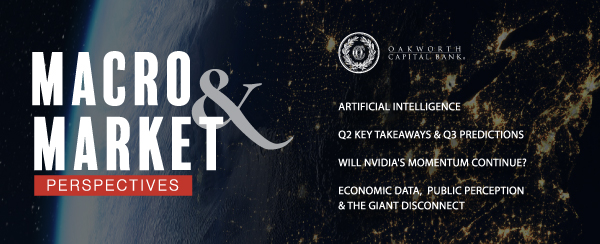INFLATION
The official inflation gauges are showing signs of improving. This means prices aren’t going up as rapidly as they once were. It does NOT mean prices are going down for the consumer. This is the primary reason there is a disconnect between what the government is celling us about the economy and what the average person is experiencing.
ARTIFICIAL INTELLIGENCE
Artificial intelligence (AI), or accelerated computing, is here to stay. It will fundamentally change our lives and how we conduct business. That is why investors have been throwing so much money at the sector. However, investors threw a lot of money at internet stocks in the late 1990s.
RATE CUTS
At the start of the year, the markets were expecting six to seven rate cuts in 2024. Now, expectations have dropped to one or two, and even those will be “data dependent.”
RATE ANXIETY
Investors have awaited Fed rate cuts for so long, they are starting to discount them altogether. However, the longer the cost of money stays as high as it is, the greater the potential for a meaningful pullback in the markets and economic activity.
VALUE STOCK REBOUND
Large-cap growth and technology stocks have been so dominant for so long, it is difficult to imagine there won’t be a rebound in traditional value stocks at some point. The only question is when it will happen.
NVIDIA
The biggest AI company, NVIDIA (NVDA), continues to grow its revenue and margins. At the end of the 2nd quarter of 2024, it appeared as though nothing could stop this juggernaut. However, at some point, the rate of growth will slow, as it always does. So, do you buy NVDA now, after the so-called easy money has been made? Or do you wait for a pullback?
G7 DISPARITY
As bad as the financial conditions may seem in the United States, they are arguably even worse in the remainder of the G7. So much so, the remainder of the developed world seems to be on the precipice of irrelevance. Only major changes to the current status quo will keep Europe from falling farther behind the United States.
STOCK MARKET RESILIENCE
Interestingly, heightened geopolitical problems haven’t deterred U.S. investors, as stocks have continued to climb. It remains to be seen just how much longer the U.S. can remain somewhat immune to the brushfires that keep popping up around the world.
GLOBAL ELECTIONS
The world is going to the polls in 2024. With a couple of exceptions, namely Mexico and to a lesser degree India, it seems people in most countries are tired of the current state of affairs and are looking for change.
LABOR MARKETS
The labor markets are starting to show small signs of weakness. Despite a large number of available jobs and a historically low unemployment rate, employers seem to be searching for proverbial unicorns. Unskilled and younger workers have been particularly affected recently.
RISING DEBT CONCERNS
The U.S. Treasury continues to drown the financial markets with debt. Washington is set to borrow an additional $2 trillion in 2024, and long-term rates should be higher than they currently are. They remain low because the Fed has eased its “quantitative tightening” program, and investors believe they will completely stop shrinking its balance sheet by the end of the year.
MERGERS & ACQUISITIONS
After a slowdown in 2022/2023, merger s & acquisitions haven’t picked up considerably in 2024. The continued high cost of money and the fact that private deals are not as cheap as they once were are the only reasons for this.
CLASSICS DRAW CROWDS
Last quarter, George Strait set the record for non-festival concert attendance, drawing over 110k fans to Kyle Field at Texas A&M. It just goes to show you, classics never go out of style.
This content is part of our quarterly outlook and overview. For more of our view on this quarter’s economic overview, inflation, bonds, equities and allocations, read the latest issue of Macro & Market Perspectives.

The opinions expressed within this report are those of the Investment Committee as of the date published. They are subject to change without notice, and do not necessarily reflect the views of Oakworth Capital Bank, its directors, shareholders or employees.


